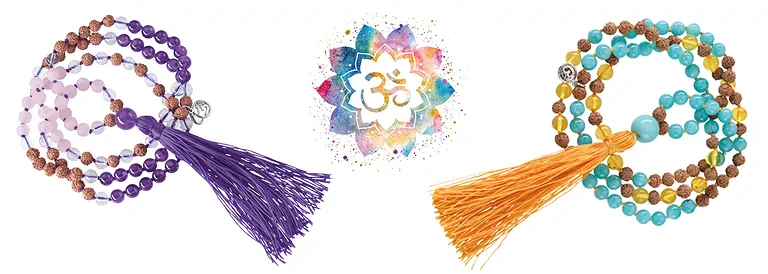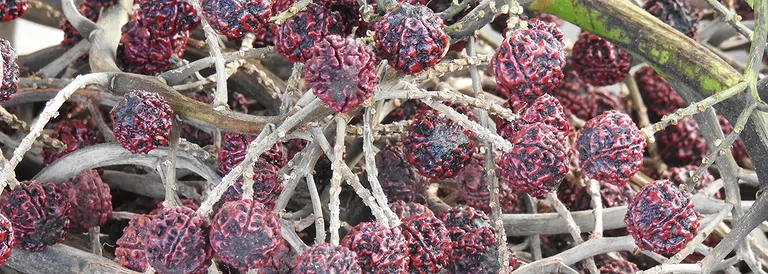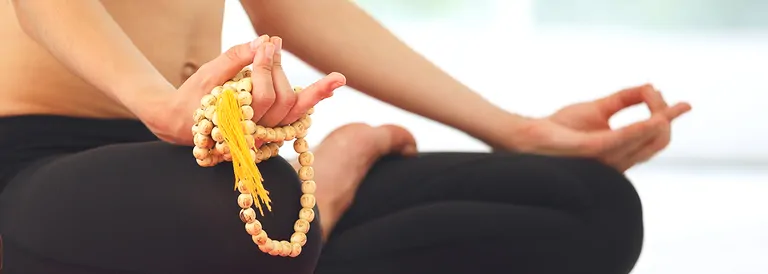
Gemstone Malas
The term "mala" comes from Sanskrit (माला, pronounced: mālā) and means translated meditation necklace, meditation wreath. Traditionally, malas are made of special materials, such as gemstones, wood or seeds. For thousands of years, malas have been used by Buddhists and Hindus to aid in meditation, especially japa or mantra meditation. Here, a selected affirmation or mantra is spoken aloud and repeated several times. In order to be able to fully tune into the mantra and not be distracted by counting along with the repetitions, the mala is used as an aid to counting. Thus, a deeper, more intense energy in meditation can be achieved. Mantra meditation is already mentioned in the Indian Mahabharata epic around 400 BC. Traditionally, however, the knowledge of the mantras and their effect is passed on by the master to his students only orally; presumably, therefore, the historical origin of the malas and their application for
meditation is much older.
Four sections of a gemstone mala
Malas have a total of four different sections: The first 27 beads of the mala are dedicated to the passions to be overcome from "delusion to disregard for the laws. From these develop the qualities of beads 28 to 54 - the "realization of reality" to "being carried by the laws". The following beads 55 to 81 deal with the heart's dullnesses that have to be overcome, from neighbor-blindness to sarcasm and resentment. The subsequent beads (82 to 108) are the qualities to be achieved from "right knowledge in thinking" to "recognizing the meaning of all phenomena".
Guru bead
In addition, malas usually have another, often somewhat larger bead, the so-called Guru bead, also called Bindu, Meru or Sumeru. Occasionally, a sphere with a different material, color, or surface is used as a guru bead. This particular bead is not used in meditation and counting the mantra, but rather serves to interrupt the flow of energy in the mala; preventing the meditation energy from running endlessly in the prayer chain. In addition, the guru bead serves as an orientation for the beginning and end of the meditation to determine when one has once had all 108 beads of the mala in hand as a counting aid when reciting mantra.
For yoga studios and other professionals: Hand-knoted gemstone malas

The 108 beads of the mala
Why do malas have 108 beads of all things? An answer to this question gives the initially complicated-looking formula:
11 * 22 * 33 = 108
1 * (2*2) * (3*3*3) = 108
11 symbolizes "advaita", the so-called non-duality; there is only one ultimate truth, one absolute principle, one highest knowledge.
22 symbolizes "dukkha", the 2 * 2 = 4 truths of suffering, sorrow, pain, impermanence, imperfection. These can be overcome by achieving advaita (11 ).
33 symbolizes 3 * 3 * 3 = 27 qualities of consciousness in the dukkha ( 22 ), which must be overcome or realized.
Because of the long tradition of malas, mostly without written information, but can not be said for sure whether this explanation is correct or whether other approaches have their justification: For example, in ancient Indian Sanskrit there are a total of 54 letters - each in male and female version; so 54 * 2 = 108 letters. Also with the chakras, the energy paths and energy points of the body, there are models that assume 108 "lines" in the body.
In Hindu astrology, there are 12 signs of the zodiac and 9 planets - 12 × 9 = 108. In the Thai language, the 108 also means an indescribably large number of things at the same time. Also in the famous temple complex of Angkor Wat in Cambodia there are numerous references to the number 108.
Undeniable, however, is the special meaning of the number 108; so many Buddhist temples have staircases with 108 steps and with Thai Buddha figures are usually 108 characters on the soles of the feet.

Rudraksha
Rudraksha is a seed traditionally used to make prayer chains. It comes from various species of evergreen trees of the genus Elaeocarpus. They are traditionally dedicated to the Hindu deity Shiva and are worn for protection and inspiration. The Rudrakshas as a natural-looking jewelry are widely used in India and Nepal and are valued similarly to gemstones.
Its origin is the word "Rudraksha" in two Sanskrit words: "Rudra" and "Aksha". Translated, this means "Lord Shiva" and "tears". After a meditation for the welfare of all living beings on earth, Shiva awoke, opened his eyes and tears fell on the earth. From these tears then grew the Rudraksha trees.
Rudrakshas and other findings for knotting Malas - for professional users only

Familiar and popular mantras
Om (Oṃ āḥ hūṃ)
The most famous mantra; it is composed of the three letters A U M and represents the trinity, e.g. past, present and future. Om is the primordial syllable of the universe. The Om mantra is often used at the beginning and end of yoga sessions.
Lokah Samastah Sukhino Bhavantu
derives from Vedic scriptures; translates to "May all beings in all worlds be happy!"; used at the end of yoga sessions to strengthen world peace.
Asato Ma Sat Gamaya
Dates from the earliest times of Hinduism, so this mantra is at least 2800 years old, but probably much older. Important mantra for gaining knowledge, overcoming darkness and ignorance. Means translated "Lead me from ignorance to light, to knowledge."

The colors of the gemstones for the malas and their effect
red:
strongly stimulating, accelerating, stimulating
The processing of life experience is promoted, so that spiritual growth processes are strengthened. The inner imagery is strengthened, feelings emerge more clearly.
pink:
peaceful, sensitive
Promotes the ability to feel feelings, both their own and those of fellow human beings. The sensitivity is strengthened.
orange:
gently stimulating, invigorating, vitalizing
Promotes quality of life and optimism, makes cheerful and cheerful. This creates space for sensuality and spontaneity; harmony and balance can be found.
brown:
relaxes, gathers, focuses
Promotes strength and stability, brings serenity and grounding. By focusing on their own values and abilities, security is conveyed.
yellow:
encouraging, life-affirming, strengthening
Gives happiness, carefree and drive. The understanding of daily experience is strengthened, the meaning in their own lives can be discovered. The self-confidence and belief in their own success are supported.
green:
harmonizing, neutralizing, liberating
Discharges negative emotions and thus brings long-term inner peace; will to live and initiative are strengthened. Supports an optimistic attitude; color of hope.
blue:
cooling, calming, relaxing
Promotes courage and honesty, keeps moving. Things come into flow, as attachments and external influences are recognized and let go; color of knowledge. Strength and inner balance can develop.
violet:
liberating, purifying, dissolving
Promotes understanding, brings mental peace and serenity. Memories, wealth of ideas and awareness are strengthened. Awakens primal knowledge and promotes the reception and exchange of information.
white/clear:
neutral
Support the existing, clarify existing. Promote and support the effect of other colored minerals, bringing fullness and perfection. Strengthen clarity, purity and self-knowledge.
black:
neutral
Absorbs excess energy and thus has a relaxing effect. Distractions are kept away, the concentration on the essentials is supported. Brings hidden things to light.
Tip for further reading:
Michael Gienger: "Die Steinheilkunde" Neue Erde Verlag Saarbrücken, 2014